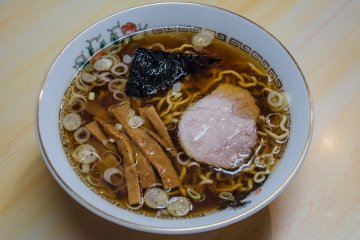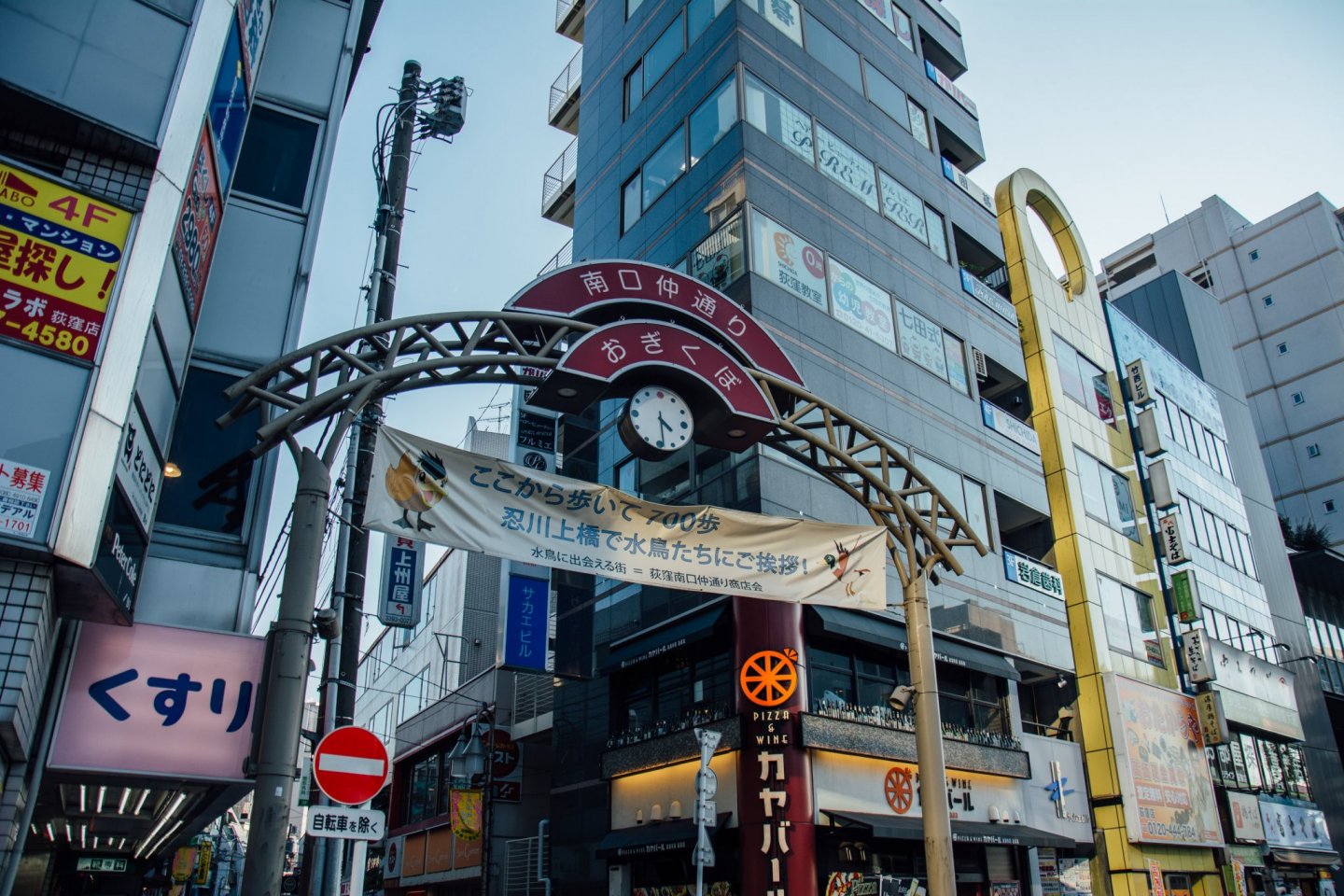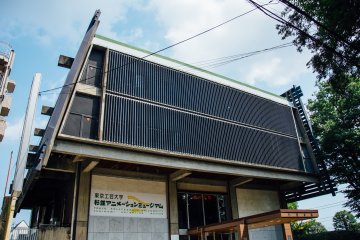

Ogikubo
Nature, ramen and animation in abundance
Things to do in Ogikubo
About Ogikubo
Ogikubo with its rivers, bountiful nature, shotengai and leafy suburban atmosphere (despite being located 15 minutes from Shinjuku), is an urban sanctuary and one deserving of anyone looking for a touch of respite from the urban chaos of deepest, darkest central Tokyo.
One of Ogikubo’s most enduring legacies is that it’s the birthplace of Tokyo ramen. In the late 40s, when Tokyo was still reeling from the aftermath of the war, residents were looking for filling and affordable meals and ramen was, ultimately, the end result. Harukiya, established in 1949, has been a favorite of Ogikubo residents and visitors looking for an authentic taste of Tokyo. The recipe for its soy sauce-style ramen (based on a dried sardine broth which differentiates it from other ramen) hasn’t changed one iota since its inception and a few years ago it opened a sister branch in nearby Kichijoji. It’s a testament to the attention to detail and pride in the local cuisine that makes Harukiya a staple for ramen lovers all over the capital.
Ogikubo's Three Gardens refer to the serene outdoor locations to be found at Otaguro Park, Tekigaiso and Kadokawa Garden. Providing a welcome rest spot for Ogikubo's locals, they have become known as a symbol of the region.
With more than 130 animation companies based in the district of Suginami it will come as no surprise that the Tokyo Polytechnic University Suginami Animation Museum is based in Ogikubo too. A haven for anime geeks and anyone with a passing interest, it provides three floors devoted to everything animation including the history behind it, the major animators in Japanese culture and has an array of interactive activities for children and adults alike.
Ogikubo is a geographical smorgasbord of cultural elements and the locals are proud of its eclecticism and, essentially, it acts as a topographical mirror of enduring Japanese interests such as nature, anime and cuisine. Distinct from its neighbors, Asagaya and Nishi-Ogikubo, Ogikubo is very much its own town and one which revels in its cultural and historical verdancy.
MoreTokyo Top 10
-
![24-Hour Yaro Ramen in Shibuya Revolutionizes Noodles With an All New Type of Ramen Taking Over Tokyo 24-Hour Yaro Ramen in Shibuya Revolutionizes Noodles With an All New Type of Ramen Taking Over Tokyo]() 1
124-Hour Yaro Ramen in Shibuya Revolutionizes Noodles With an All New Type of Ramen Taking Over Tokyo
Tokyo -
![Tokyo's teamLab Planets Takes Top Asia Title Tokyo's teamLab Planets Takes Top Asia Title]() 2
2Tokyo's teamLab Planets Takes Top Asia Title
Tokyo -
![Overtourism in Japan: How Bad Is It? Overtourism in Japan: How Bad Is It?]() 3
3Overtourism in Japan: How Bad Is It?
Tokyo -
![Japan's First Official Tamagotchi Factory! Opens Japan's First Official Tamagotchi Factory! Opens]() 4
4Japan's First Official Tamagotchi Factory! Opens
Tokyo -
![Watching Kabuki in Tokyo Watching Kabuki in Tokyo]() 5
5Watching Kabuki in Tokyo
Tokyo -
![Discover Shiga Prefecture: Events at COCOSHIGA in Tokyo Discover Shiga Prefecture: Events at COCOSHIGA in Tokyo]() 6
6Discover Shiga Prefecture: Events at COCOSHIGA in Tokyo
Tokyo - Sponsored -
![A Festive Escape at The Tokyo EDITION Hotels A Festive Escape at The Tokyo EDITION Hotels]() 7
7A Festive Escape at The Tokyo EDITION Hotels
Tokyo -
![Celebrate Christmas in Style at Grand Hyatt Tokyo Celebrate Christmas in Style at Grand Hyatt Tokyo]() 8
8Celebrate Christmas in Style at Grand Hyatt Tokyo
Tokyo -
![A Taste of Shiga at COCOSHIGA A Taste of Shiga at COCOSHIGA]() 9
9A Taste of Shiga at COCOSHIGA
Tokyo - Sponsored -
![PokéPark KANTO Opening Sooner Than Expected PokéPark KANTO Opening Sooner Than Expected]() 10
10PokéPark KANTO Opening Sooner Than Expected
Tokyo
-
![Tokyo Christmas Market Tokyo Christmas Market]() 1
1Tokyo Christmas Market
Tokyo -
![Your Name: Real-Life Locations in Tokyo Your Name: Real-Life Locations in Tokyo]() 2
2Your Name: Real-Life Locations in Tokyo
Tokyo -
![Shibuya Blue Cave Illumination Shibuya Blue Cave Illumination]() 3
3Shibuya Blue Cave Illumination
Tokyo -
![Bad Bunny Debí Tirar Más Fotos World Tour Bad Bunny Debí Tirar Más Fotos World Tour]() 4
4Bad Bunny Debí Tirar Más Fotos World Tour
Tokyo -
![January Grand Sumo Tournament (Tokyo) January Grand Sumo Tournament (Tokyo)]() 5
5January Grand Sumo Tournament (Tokyo)
Tokyo -
![Tori-no-Ichi Tori-no-Ichi]() 6
6Tori-no-Ichi
Tokyo -
![Winter Comiket Winter Comiket]() 7
7Winter Comiket
Tokyo -
![Rikugien Garden Autumn Illumination Rikugien Garden Autumn Illumination]() 8
8Rikugien Garden Autumn Illumination
Tokyo -
![Marunouchi Winter Illuminations Marunouchi Winter Illuminations]() 9
9Marunouchi Winter Illuminations
Tokyo -
![Azabudai Hills Christmas Market Azabudai Hills Christmas Market]() 10
10Azabudai Hills Christmas Market
Tokyo
-
![A Festive Escape at The Tokyo EDITION Hotels A Festive Escape at The Tokyo EDITION Hotels]() 1
1A Festive Escape at The Tokyo EDITION Hotels
Tokyo -
![Celebrate Christmas in Style at Grand Hyatt Tokyo Celebrate Christmas in Style at Grand Hyatt Tokyo]() 2
2Celebrate Christmas in Style at Grand Hyatt Tokyo
Tokyo -
![Discover Shiga Prefecture: Events at COCOSHIGA in Tokyo Discover Shiga Prefecture: Events at COCOSHIGA in Tokyo]() 3
3Discover Shiga Prefecture: Events at COCOSHIGA in Tokyo
Tokyo -
![A Taste of Shiga at COCOSHIGA A Taste of Shiga at COCOSHIGA]() 4
4A Taste of Shiga at COCOSHIGA
Tokyo -
![24-Hour Yaro Ramen in Shibuya Revolutionizes Noodles With an All New Type of Ramen Taking Over Tokyo 24-Hour Yaro Ramen in Shibuya Revolutionizes Noodles With an All New Type of Ramen Taking Over Tokyo]() 5
524-Hour Yaro Ramen in Shibuya Revolutionizes Noodles With an All New Type of Ramen Taking Over Tokyo
Tokyo -
![Yakiniku Inoue Ginza Yakiniku Inoue Ginza]() 6
6Yakiniku Inoue Ginza
Tokyo -
![Tokyo with Kids: KidZania Tokyo with Kids: KidZania]() 7
7Tokyo with Kids: KidZania
Tokyo -
![Brisk Stand Suidobashi Brisk Stand Suidobashi]() 8
8Brisk Stand Suidobashi
Tokyo -
![Asakusa GYUUNA Yadoki: Premium Eel & Wagyu Beef in Asakusa Asakusa GYUUNA Yadoki: Premium Eel & Wagyu Beef in Asakusa]() 9
9Asakusa GYUUNA Yadoki: Premium Eel & Wagyu Beef in Asakusa
Tokyo -
![Tiffany Blue Box Café Opens in Ginza Tiffany Blue Box Café Opens in Ginza]() 10
10Tiffany Blue Box Café Opens in Ginza
Tokyo
Latest Ogikubo Reports

Suginami Animation Museum
FeaturedLess than 20 minutes away from either Shinjuku or Shibuya, Ogikubo makes for an easy trip from Tokyo’s central tourist hubs. I..

Otaguro Park
Sleiman AziziOtaguro Park in Suginami City is a free Japanese strolling garden found on the estate of the former music critic Motoo Otaguro...
About Ogikubo
Ogikubo has had an historic and profound relationship with a range of disparate cultural markers such as classical music, literature, ramen and manga for decades. Much like its sibling Nishi-Ogikubo, which sits at the next stop on the Chuo Line, Ogikubo is serene, quiet but with more than enough going on to keep visitors busy on a day or weekend trip.
Ogikubo with its rivers, bountiful nature, shotengai and leafy suburban atmosphere (despite being located 15 minutes from Shinjuku), is an urban sanctuary and one deserving of anyone looking for a touch of respite from the urban chaos of deepest, darkest central Tokyo.
One of Ogikubo’s most enduring legacies is that it’s the birthplace of Tokyo ramen. In the late 40s, when Tokyo was still reeling from the aftermath of the war, residents were looking for filling and affordable meals and ramen was, ultimately, the end result. Harukiya, established in 1949, has been a favorite of Ogikubo residents and visitors looking for an authentic taste of Tokyo. The recipe for its soy sauce-style ramen (based on a dried sardine broth which differentiates it from other ramen) hasn’t changed one iota since its inception and a few years ago it opened a sister branch in nearby Kichijoji. It’s a testament to the attention to detail and pride in the local cuisine that makes Harukiya a staple for ramen lovers all over the capital.
Ogikubo's Three Gardens refer to the serene outdoor locations to be found at Otaguro Park, Tekigaiso and Kadokawa Garden. Providing a welcome rest spot for Ogikubo's locals, they have become known as a symbol of the region.
With more than 130 animation companies based in the district of Suginami it will come as no surprise that the Tokyo Polytechnic University Suginami Animation Museum is based in Ogikubo too. A haven for anime geeks and anyone with a passing interest, it provides three floors devoted to everything animation including the history behind it, the major animators in Japanese culture and has an array of interactive activities for children and adults alike.
Ogikubo is a geographical smorgasbord of cultural elements and the locals are proud of its eclecticism and, essentially, it acts as a topographical mirror of enduring Japanese interests such as nature, anime and cuisine. Distinct from its neighbors, Asagaya and Nishi-Ogikubo, Ogikubo is very much its own town and one which revels in its cultural and historical verdancy.



























